Archive of the Mendocino Heritage Artists
Charles Marchant Stevenson (1927-2004)
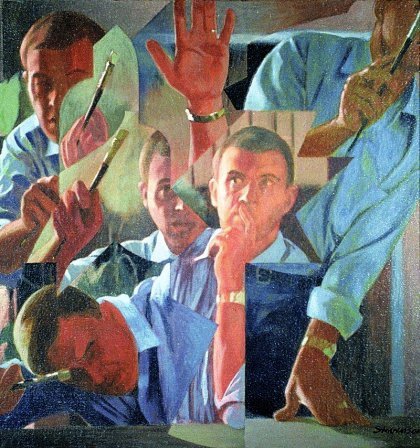
Charles Marchant Stevenson III was born to Mildred and Charles Marchant Stevenson on August 29, 1927 in Washington, DC. The Stevenson Studio at the Mendocino Art Center was the gift of the artist’s parents.
Stevenson finds his path
“At ten years old I had a revelation of talent, and I won a scholarship to the adult school of the Corcoran Academy of Fine Art… It was an interesting experience, being a child, partaking in these adult classes.
“We went to the National Museum in Washington, D.C., the Mellon Gallery and copied paintings…[Andrew William Mellon founded of the National Gallery of Art], and copied paintings… I copied an El Greco, The Virgin of Saint Tecla and Saint Inez, which is a very elongated, sinuous, flame-like brush stroke painting.
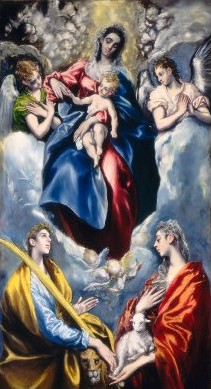
I was dissatisfied with the color, because I couldn’t get it as rich and luminous as the original. Then I met a man who was a professional copier, and he told me about glazing techniques.
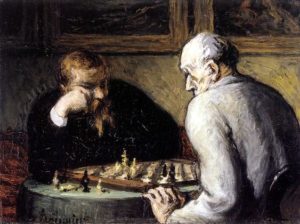
I was much more satisfied with my second painting, a copy of The Chess Players by Honoré Daumier, because I followed this man’s suggestions for glazing transparent colors over a gray or beige underpainting, as the old masters did.
It was 1938 and I was eleven years old.
[From interviews with Matt Leach and Antonia Lamb. A&E Magazine, August 1994]
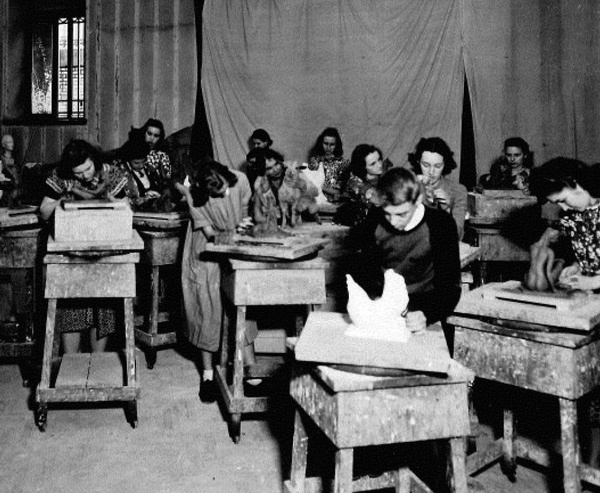
World War II
In September 1945, immediately after his eighteenth birthday (8/29/1944), Stevenson enlisted in the United States Navy. His service assignments included work as illustrator for the morale magazine All Hands, art director for Training Bulletin, and editor of Naval Training.
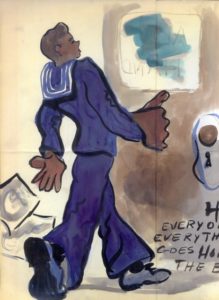
After the War
Thanks to the G.I. Bill (the Servicemen’s Readjustment Act of 1944), like many other veterans, Stevenson continued his education free of charge, attending the Pennsylvania Academy of Fine Art and the University of Pennsylvania, in Philadelphia.
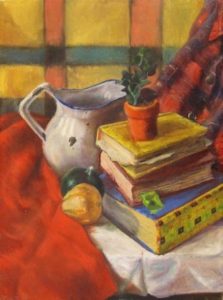
Two and a half years later Stevenson ended his formal education, and married briefly. He found work in a series of art-related jobs that were far from his dream of life as an artist, as an apprentice stained glass church window designer (Paine-Speyers factory) in Patterson, New Jersey, as an attendant and art therapist in a mental hospital in Hartford, Connecticut, and as an advertising artist for department stores in Dallas and New York City.
San Francisco
Stevenson moved to San Francisco in 1954 to work for the commercial advertising agency Wyatt & Welsh. Two years later he was still in San Francisco, self-employed, and in demand as a muralist and portrait painter.
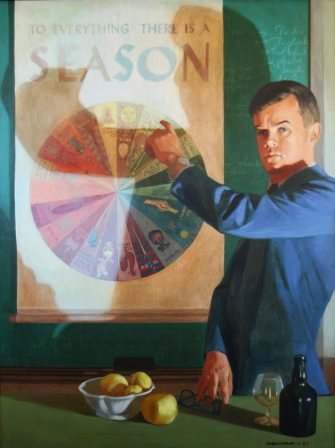
During Stevenson’s last four years in San Francisco, he was owner (in partnership with Arnold Borley), and president, of Stevenson Graphics, representing fifteen artists specializing in advertising art.
The Artist Finds His Way Home
The bare bones of Charles Marchant Stevenson’s life to this point conceal a cultured, gracious and generous man searching for the spiritual within the mundane.
Stevenson told Leach and Lamb (1994), “Years ago a fortuneteller told me that I had a chance to remake my entire life and I said, ‘What I’d really like to find is someplace like Carmel or Monterey was, when all the artists and writers were there.’
“And she said, ‘Mendocino!'”
In 1961 Stevenson closed the San Francisco chapter of his life.
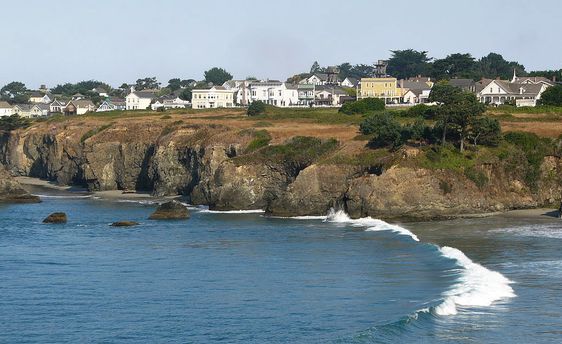
“I put everything in the back of my old Buick and came to this wonderland, and found that the rumors were a little off. The town was then pretty sad-seeming because half of the buildings were boarded up and almost every house in town needed paint or something done to it.
“The reason I stayed was because of Bill and the Art Center. We had it in our hearts that our purpose was somehow to revive this town and make it a center for art…I remember praying that something would happen, that all those houses would get painted and fixed up again and that the town would not be trashed with awful architecture. And we worked hard to make it happen. To attract people. And they came…”
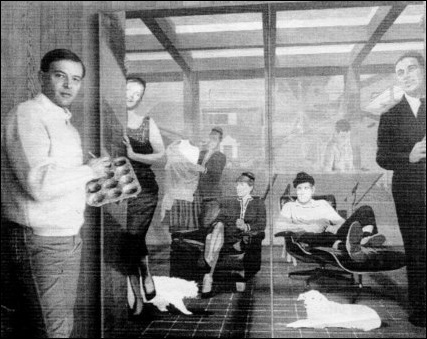
Bill Zacha
On arriving in Mendocino, Stevenson phoned Dorr Bothwell, his only acquaintance in the town, whom he knew slightly from San Francisco metaphysical circles. Bothwell invited Stevenson to her studio, then took him with her to dinner at the home of Mendocino Art Center founders Bill and Jennie Zacha.
That night Zacha rented Stevenson a small place behind their house at 640 Little Lake Street, and gave him two weeks worth of architectural drafting work.
Stevenson found part-time work at several local bars and restaurants, but even working a “Mendocino Bouquet” of jobs, Stevenson found himself unable to meet his rent.
Some of Stevenson’s paintings were hanging at the Seagull Restaurant where he waited tables. By coincidence, on the day the rent was due, a Seagull customer saw a painting he liked and called Stevenson at the Zacha’s (Stevenson had no private phone), offering to buy the painting for half price. Bill Zacha overheard, and broke in, “Make them pay double!”
Telling the story to journalist Robyn Roberson [Outlook, August 1994], Stevenson says, “by the end of the day someone else had bought the painting for my price and rent was paid… Bill took my work to his Bay Window Gallery and whenever I needed money, he sold my work. It was just like magic!”
The Art Center
Then Bill Zacha offered Stevenson a job teaching at the Mendocino Art Center.
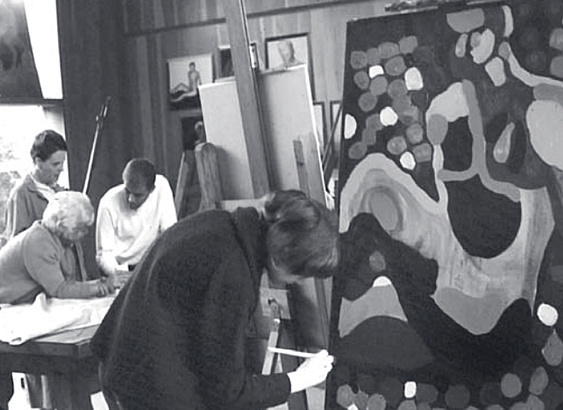
Stevenson’s years of study at the Corcoran, and at the Pennsylvania Academy of Fine Art, the years of practical application of his skills, his creative vision, insight, enthusiasm, and personal warmth made him an especially inspiring teacher. He taught at the Mendocino Art Center for almost forty years, guiding generations of art students.
Stevenson’s Art
Charles Marchant Stevenson’s habits of precise observation, his understanding of history, his hermetic studies and use of sacred geometry in composition, and his warm humanity, all contribute to work filled with power, insight and impish humor. He is best known for his dynamic large-format portraits, usually painted in acrylics, often on a surface of gessoed cheesecloth on wood or masonite panels, but his subject matter is as varied as his many interests.
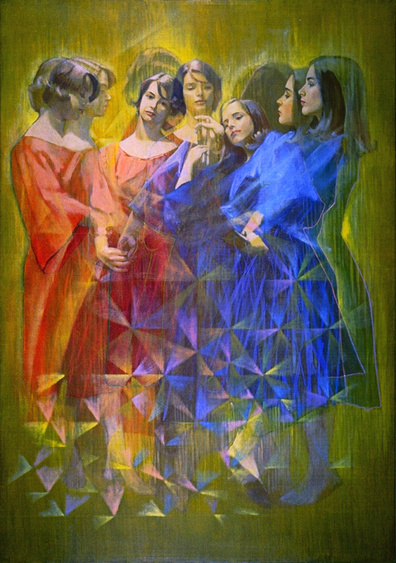
Stevenson’s large paintings are so eye-popping that art critics sometimes fail to mention his work in other media. Stevenson’s drawings, and watermedia paintings are smaller, but equally remarkable. Stevenson’s serigraphs are brilliant.
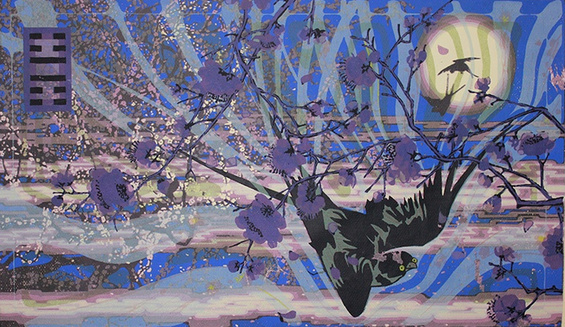
Stevenson, Anglican by birth, explored many philosophies and religions in his artwork.
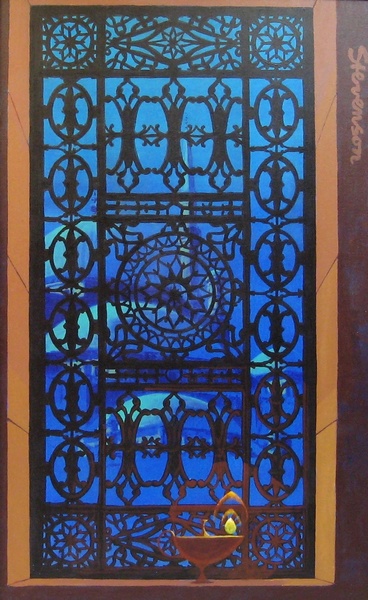
Lucia Zacha
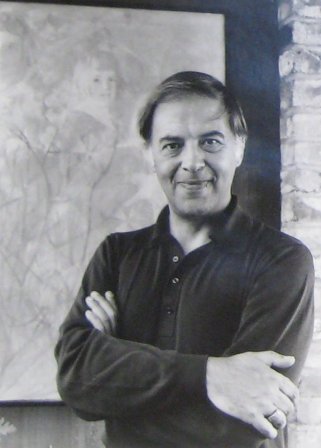
Bill and Jennie Zacha’s daughter Lucia remembers, “I think I first met Charles – Chuck is what we all called him then – in the studio when I was six or seven. I know I was seven when he painted my portrait. He was magical. I was supposed to be picking flowers and there I was, out in a field with all these wild mustard weeds, yet when he was finished I was picking beautiful flowers.”
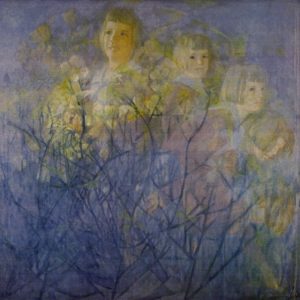
Saint Michael’s and All Angels
Between 1974 and 1984, Stevenson designed the magnificent stained glass Angel Windows at the Episcopal Church of Saint Michael’s and All Angels.
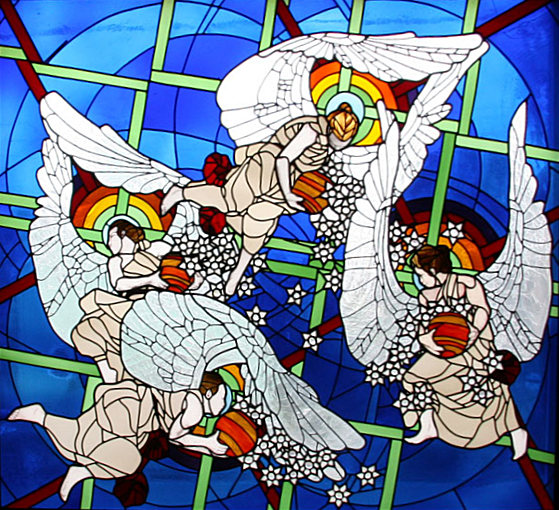
Fox & Hare
Some consider Stevenson’s most important work to be the masterful suite of pen and ink drawings illustrating Chester Anderson’s sharply comic roman à clef, Fox & Hare: the story of a Friday evening.
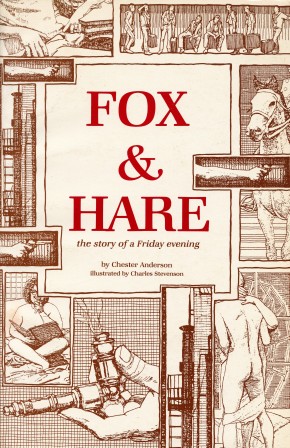
Stevenson/Leach Studios
In 1989, while working on sets for the Gloriana Opera Company production of Peter Pan, Stevenson met gifted young Mendocino painter Matt Leach. Together they completed the sets for Peter Pan and designed a poster for the show. Leach had deep admiration and respect for Stevenson and his work; Stevenson saw something of himself in the creative energy and dedication of the younger artist. They continued their artistic collaboration and soon, at Stevenson’s invitation they formed Stevenson/Leach Studios (Paris, London, New York, Mendocino).
Stevenson/Leach Studios produced spectacular work. The Stevenson/Leach series of large double-sided painted screens, include the award-winning Mendocino Afterglow.
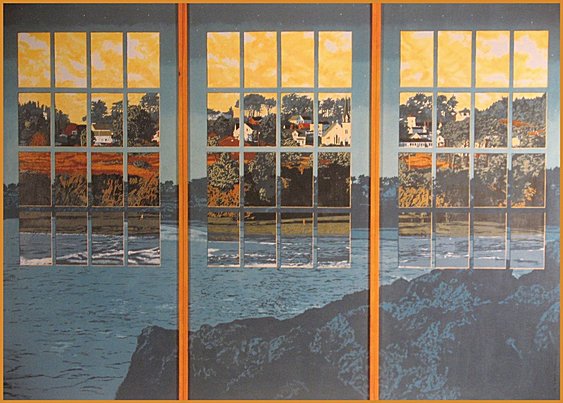
Retrospective (1994)
No single Mendocino gallery was large enough to hang a truly representative retrospective of Stevenson’s large body of work, so in August and September 1994, the Highlight Gallery and the Mendocino Art Center shared the presentation of The Charles M. Stevenson Retrospective.
Of the retrospective, A&E Magazine editor Gerry Huckaby writes in “Charles Stevenson: The Nature of Reality” [A&E Magazine, August 1994]:
After the gasps of wonder at individual pieces…after the slack-jawed incredulity …after the buzzing in the brain that can’t absorb any more, and the flattening of vision that may just function well enough for you to find somewhere to sit down – you know then that it is not going to be an easy task to comprehend this body of art.” Huckaby continues, “He is…a painter who has turned away from “court portraiture” (the Duponts, for instance)
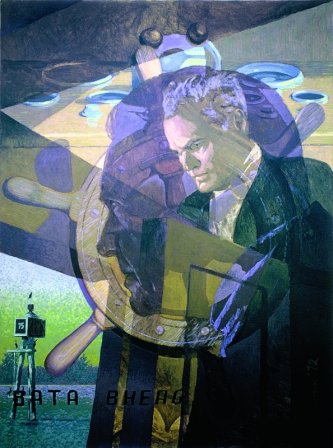
and continued what was and is essentially a spiritual quest…It is not a matter of humanism (to ask what it means to be a man), but modern spiritualism where theology is another name for physics, where the question is “what does it mean to be.” Charles Stevenson could easily be called “the physicist of painting.”
Performing Arts
Stevenson’s friends shared his dedication to community, and most shared his passion for the performing arts, which found expression onstage and off. He was a gifted actor, director, designer, and producer.
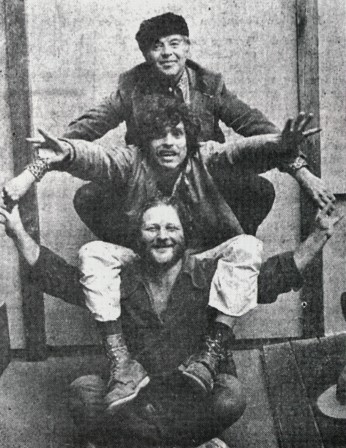
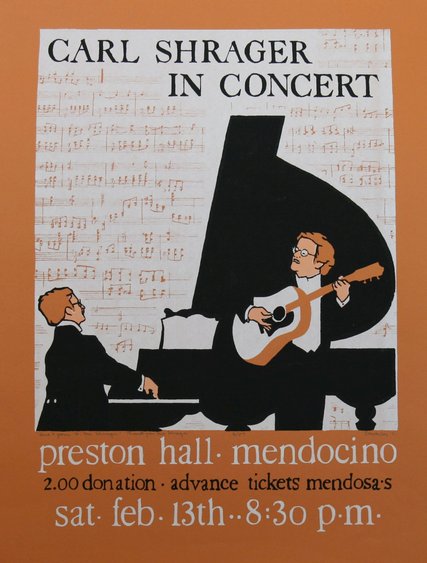
Stevenson/Burnham Bequest
Stevenson and his longtime companion Tom Burnham made the Art Center a spectacular gift of land in the heart of the village, with the stipulation that low-cost housing for artists be built on the property. That the Art Center was unable to fulfill the Stevenson/Burnham dream diminishes neither its beauty, nor the selfless example they set.
Like his friends the Zachas, Charles Marchant Stevenson gave unstintingly to his community, his time, his talent, his resources, sponsoring exhibitions, concerts, and plays, and providing grants to local musicians and writers.
Last Years and the Second Saturday Salons
Charles Marchant Stevenson: It was my longtime dream to be part of a golden age of art. What happened in Mendocino gave us the feeling that we could influence the course of events by our dreams and our visions. The people who came helped complete our connection with the arts and I think we did have a golden age.
Charles Marchant Stevenson helped create that golden age and in his last years, when Mendocino’s golden age was passing into myth, Stevenson reenvisioned it, willed it back into being long enough to awaken the dream in the hearts of a new generation.
Aided by his close friend and biographer, the artist Pamela Hunter, in his later years, in failing health, Stevenson hosted a monthly Second Saturday Salon at his house on School Street in Mendocino.
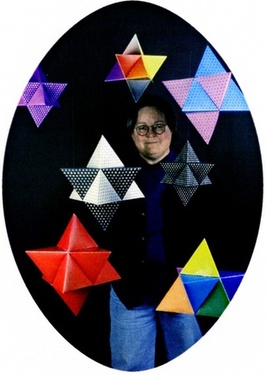
In a sensitive memorial tribute, Andarin Arvola shares this glimpse: His studio/home was a rough and tumble two-storey house with a whimsy of unexpected charm and delight tucked into every corner. At the end of a short winding path into the dense foliage of the backyard was another structure, a room of windows. There were often art projects displayed there as well. An old ornate metal bed made up with fall leaves looked especially inviting. [Real Estate Magazine: Mendocino Property, Issue 450, September 2004]
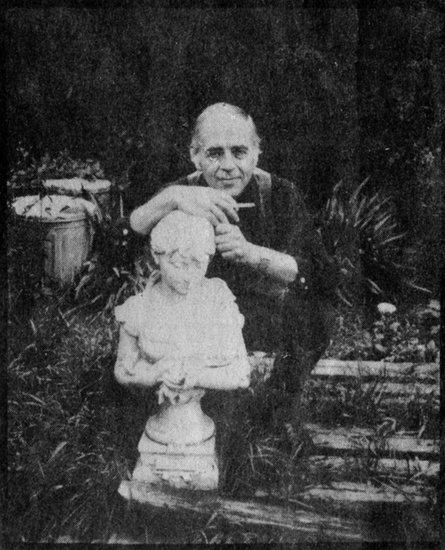
One of Charles Marchant Stevenson’s final gifts is the memory of those special evenings where food and wine were plentiful, young poets and artists shared new work, local musicians performed, and all were welcome.
– Carol Goodwin Blick (2017)
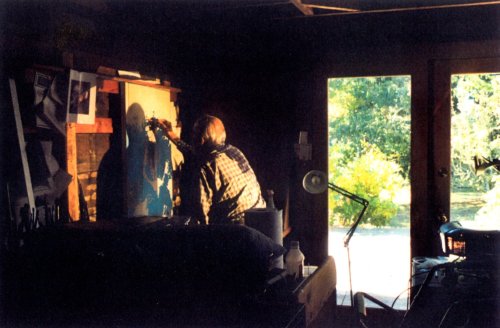
Homepage
Mendocino Heritage Artists
Stevenson in His Own Words
Art of Charles Marchant Stevenson
Stevenson/Leach Studios
Mendocino Art Center